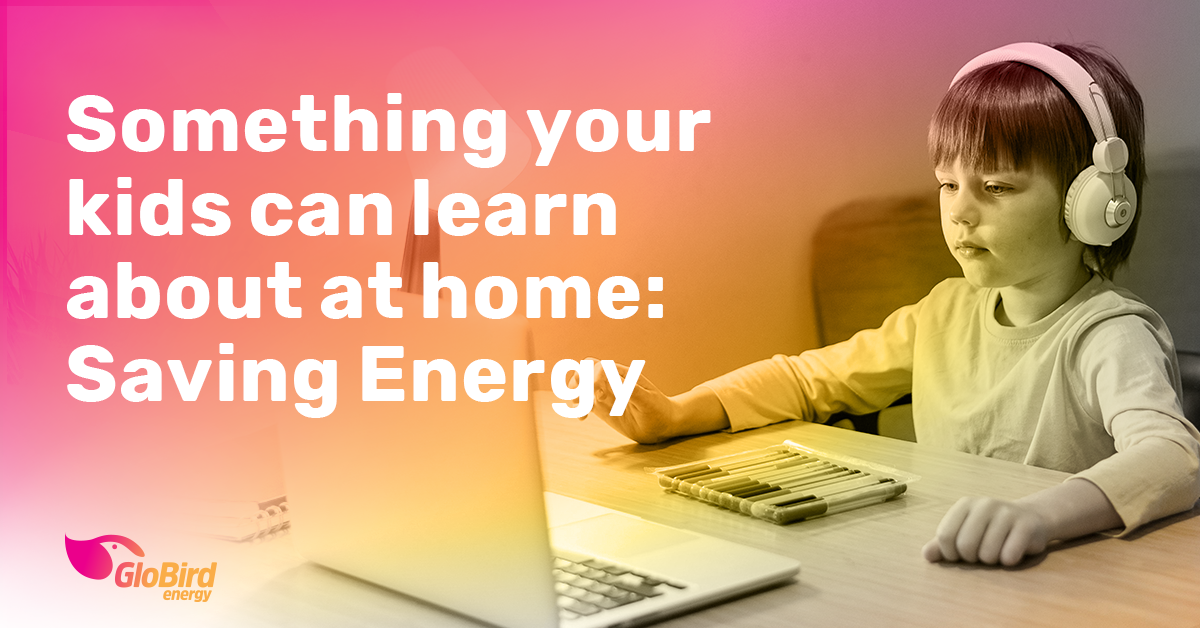Something your kids can learn about at home: saving energy
We know a lot of parents would be happy if they never again heard the term ‘remote learning’! If you are helping your kids learn at home, make sure you don’t put too much pressure on yourself or them. After all, the collective spirit of your family unit is far more important than that maths question.
While most of us have realised that we’re not teachers – at the same time appreciating just how amazing teachers are – it’s worth keeping in mind that our kids are always learning from us, whether we realise it or not.
Even when normal schooling returns, there are plenty of things that you can teach your children at home, from how to make their bed to how to make themselves a sandwich, from gardening to doing laundry, and from sorting the rubbish for recycling to saving energy.
As every parent knows, if a child takes an interest in the everyday tasks around the home, everyone benefits; the child gains experience and the parent’s load is made just a little lighter.
Kids should know a bit about energy
If you’re asked the question “How does electricity work?”, this Curious Kids article might help.
However, from a practical perspective, your kids should understand that energy isn’t free (unless you’re totally off-grid, of course). When all they know is that the lights come on at the flick of a switch, the TV works when you press a button, and plugging your device into a charger or wall socket gives it power, they probably don’t think twice.
So, explain that electricity is generated somewhere else and ‘delivered’ to your home via a system of ‘poles and wires’. Depending on their age, you might want to explain how most of the population centres on Australia’s east coast (and South Australia) are all connected via the grid, so the electricity you use might have travelled a long way to get to your house.
Or, of course, if you happen to have a rooftop solar array, you have a whole other system to explain.
Why would your kids care about saving energy?
Depending on how you and your kids already talk about such things, you might like them to help your household save money on energy costs, so you have more to spend on things they want and enjoy.
Of course, some kids respond well to a system of rewards, so they might happily buy in to reducing your electricity bill if they get to choose how to spend the savings.
Then you can explain that it’s a good thing to practise for the rest of their lives, for a variety of reasons.
The ‘big picture’ stuff goes something like:
“By reducing our energy consumption, we’re preserving resources, reducing pollution, and creating a healthier living environment.”
Create an energy-saving checklist
Walk around the house with your kids and involve them in finding all the ways you use energy.
Once you have that list, sit down with them to figure out where you might be able to cut down on your energy consumption and save money.
Start your checklist with the simple things to change everyday usage habits, for example:
-Turn off all the lights and electronics when you leave a room or leave the house.
-Decide what you want before you open the fridge door, then get in and get out (in other words, don’t just stand there looking, letting the cold air escape).
-Make the most of natural light – for example, do your homework next to a window while it’s still light outside – instead of switching on an artificial light source.
-Turn off the water when brushing your teeth.
-Take shorter showers (you can even use a timer to make a game of it: who had the shortest shower today, and what’s the household record?).
-Use the sun and wind to dry wet clothes after a swim.
Make a longer-term list of things that you can work on as a family, including things like:
-Close curtains: There’s no need to let the sun heat up your house while you’re out, meaning you’ll want to hit the air-con on button the minute you get back.
-Adjust the thermostat: Conserve energy by using a smidge less heating in winter and a chunk less air conditioning in summer.
-Replace light bulbs: Energy-efficient bulbs use up to 80% less energy than incandescent lightbulbs
-Block unwanted airflow: Start looking out for any draughts coming from under a door or around a window so you can seal up those air gaps, keeping more of the air you’ve heated or cooled in and the opposite temperature out.
We’ve got plenty more tips
Getting started is the main thing. As you get better at conserving energy, you’ll most likely find it easier to spot ways to save even more.
Not only will your children learn good habits that will stand them in good stead for the rest of their lives, but you’ll appreciate having lower electricity and gas bills.
And this might just be the perfect opportunity for you to remodel your own energy use habits, as well. After all, your kids will love keeping you in line!
Here’s some further reading you and your kids might enjoy in some of our past blog posts:
Our 12 top tips for saving energy this summer
8 creative energy saving ideas
Spring clean, check your appliances and save money
The (almost) A to Z of saving on your gas bill
How to save money by adjusting your hot water thermostat
We hope you can find ways that work for your family to reduce your energy bills.
Good luck with the home-based learning, whatever form it takes.
